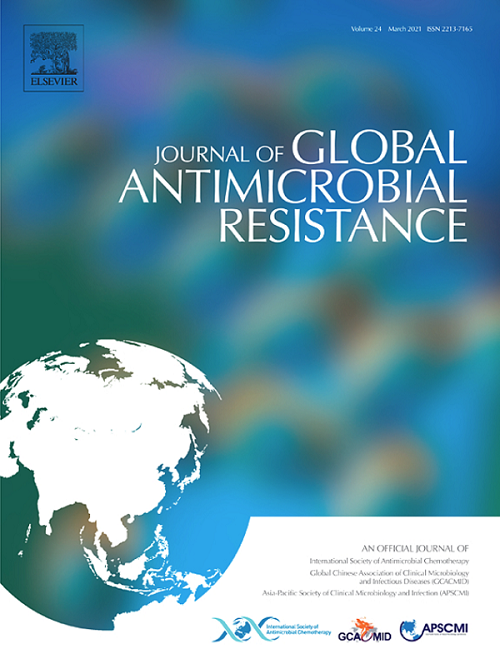Trends in prevalence and antibiotic non-susceptibility of Acinetobacter baumannii–calcoaceticus complex in Thailand (2000–2022): A secondary data analysis
IF 3.2
3区 医学
Q2 INFECTIOUS DISEASES
引用次数: 0
Abstract
Objectives
Antimicrobial resistance (AMR) is a significant global health concern. Due to its high prevalence in nosocomial infections and its increasing resistance to multiple antibiotics, Acinetobacter baumannii–calcoaceticus complex (ABC) is listed as a critical pathogen. This study aimed to determine the prevalence and antibiotic non-susceptibility trends of ABC in Thailand over two decades using national surveillance data.
Methods
We analysed secondary data from the National Antimicrobial Resistance Surveillance Thailand (NARST) from 2000 to 2022, covering 529 538 ABC isolates. Linear regression was used to evaluate trends in overall ABC prevalence and antibiotic non-susceptibility rates across ward types (ICU, inpatient, outpatient) and specimen types (sputum, blood, urine).
Results
The prevalence of ABC increased from 8% in 2000 to 14% in 2022, with inpatient wards and sputum specimens showing the highest occurrence. By 2022, the majority of tested antibiotics showed antibiotic non-susceptibility rates exceeding 70%, with increasing trends. ICU isolates had the highest non-susceptibility, followed by inpatient and outpatient settings. Although non-susceptibility rates were lower in the outpatient setting, it exhibited the steepest increasing trends. Among specimen types, urine isolates had the highest non-susceptibility, followed by sputum and blood. Carbapenem non-susceptibility increased significantly across all ward types.
Conclusions
The increasing prevalence and high non-susceptibility of ABC in Thailand highlight a growing threat to public health. These findings underscore the urgent need for enhanced infection control, robust antibiotic stewardship, and further research into molecular epidemiology and alternative therapies.
泰国(2000-2022)鲍曼-钙酸不动杆菌复群的流行趋势和抗生素非敏感性:二次数据分析。
目的:抗菌素耐药性(AMR)是一个重大的全球卫生问题。鲍曼钙酸不动杆菌(Acinetobacter baumannii-calcoaceticus complex, ABC)由于其在医院感染中的高流行率和对多种抗生素的耐药性日益增强,被列为关键病原体。本研究旨在利用国家监测数据确定泰国20多年来ABC的患病率和抗生素非敏感性趋势。方法:我们分析了2000年至2022年泰国国家抗微生物药物耐药性监测(NARST)的二手数据,涵盖529,538株ABC分离株。使用线性回归来评估不同病房类型(ICU、住院、门诊)和标本类型(痰、血、尿)的ABC总体患病率和抗生素不敏感率的趋势。结果:ABC患病率由2000年的8%上升至2022年的14%,以住院病房和痰标本发生率最高。到2022年,大多数测试抗生素的抗生素不敏感率超过70%,并且呈上升趋势。ICU分离株的不敏感性最高,其次是住院和门诊。虽然门诊的非易感性率较低,但其增长趋势最为明显。在标本类型中,尿分离株的不敏感性最高,其次是痰和血。碳青霉烯不敏感性在所有病区均显著增加。结论:泰国ABC患病率的上升和高非易感性突出了对公共卫生的日益严重的威胁。这些发现强调了加强感染控制、加强抗生素管理以及进一步研究分子流行病学和替代疗法的迫切需要。
本文章由计算机程序翻译,如有差异,请以英文原文为准。
求助全文
约1分钟内获得全文
求助全文
来源期刊

Journal of global antimicrobial resistance
INFECTIOUS DISEASES-PHARMACOLOGY & PHARMACY
CiteScore
8.70
自引率
2.20%
发文量
285
审稿时长
34 weeks
期刊介绍:
The Journal of Global Antimicrobial Resistance (JGAR) is a quarterly online journal run by an international Editorial Board that focuses on the global spread of antibiotic-resistant microbes.
JGAR is a dedicated journal for all professionals working in research, health care, the environment and animal infection control, aiming to track the resistance threat worldwide and provides a single voice devoted to antimicrobial resistance (AMR).
Featuring peer-reviewed and up to date research articles, reviews, short notes and hot topics JGAR covers the key topics related to antibacterial, antiviral, antifungal and antiparasitic resistance.
 求助内容:
求助内容: 应助结果提醒方式:
应助结果提醒方式:


